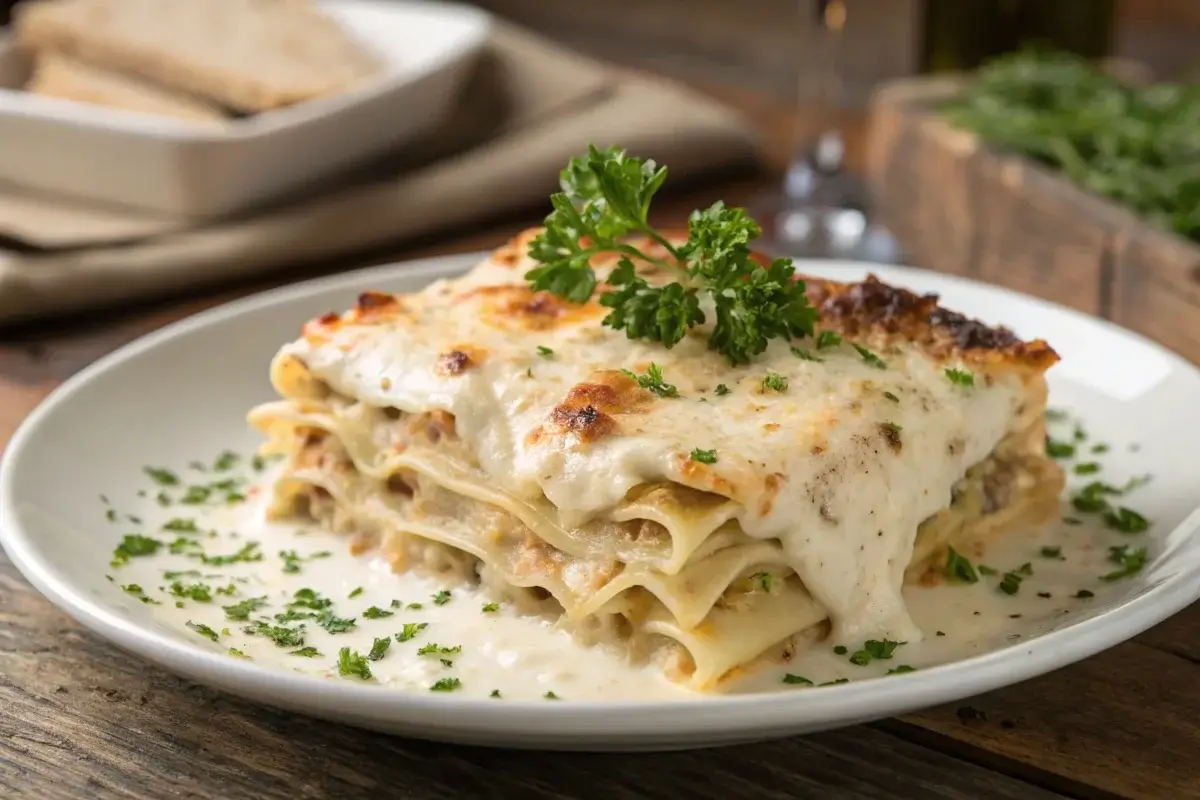Alfredo lasagna offers a luxurious alternative to traditional lasagna, combining the creamy richness of Alfredo sauce with the layered goodness of a classic Italian favorite. If you’re a fan of comforting dishes that ooze with flavor, this recipe is the perfect addition to your repertoire. This guide will take you through everything from the origins of Alfredo sauce to crafting the perfect lasagna layers.
What Makes Alfredo Lasagna Unique?
Unlike its tomato-based counterpart, Alfredo lasagna is defined by its creamy, cheese-laden layers. It skips marinara sauce in favor of Alfredo sauce, a decadent blend of butter, cream, and Parmesan cheese. The result is a dish that’s both rich and versatile, allowing for the addition of proteins like chicken or shrimp and vegetables like spinach or artichokes.
Why Choose Alfredo Lasagna?
- A creamy, indulgent flavor profile.
- A great way to use homemade Alfredo sauce or upgrade store-bought varieties.
The Origins of Alfredo Sauce and Its Adaptation to Lasagna
Alfredo sauce traces its roots back to early 20th-century Rome, where it was created by Alfredo di Lelio for his pregnant wife. The simple combination of butter, Parmesan cheese, and pasta quickly became a culinary sensation. Its introduction to lasagna is a modern twist, transforming an Italian-American staple into something truly innovative.
- Traditional Alfredo Sauce: Butter, Parmesan, and cream.
- Adapted for Lasagna: Thickened for structure and layered with cheeses and noodles.
This combination provides an indulgent, hearty meal perfect for special occasions or weeknight dinners.
Essential Ingredients for Alfredo Lasagna
Creating the perfect Alfredo lasagna starts with the right ingredients. The creamy layers depend on fresh cheeses, quality noodles, and flavorful add-ins.
Choosing the Best Cheese: Mozzarella, Parmesan, and More
Cheese is at the heart of Alfredo lasagna. Here’s what you’ll need:
- Mozzarella: For gooey layers and a golden topping.
- Parmesan: The sharp, nutty flavor elevates the sauce.
- Ricotta or Cottage Cheese: Adds creaminess to the filling.
Homemade Alfredo Sauce vs. Store-Bought
While store-bought Alfredo sauce can save time, nothing beats the flavor of a freshly made Alfredo sauce. Here’s why:
- Homemade: Allows for customization of thickness and flavor.
- Store-Bought: Ideal for quick preparation but often contains preservatives.
Kitchen Tools You’ll Need
Having the right tools makes the process smoother, ensuring every layer is perfect.
Must-Have Bakeware and Utensils
- Deep Baking Dish: Ensures the layers don’t overflow.
- Silicone Spatula: Helps spread sauce evenly.
- Cheese Grater: For fresh, finely shredded Parmesan.
Tips for Perfect Layering Techniques
- Use a ladle to spread sauce evenly over noodles.
- Alternate cheese and sauce layers for optimal texture.
- Keep layers thin to avoid an overly thick final dish.
Nutritional Overview of Alfredo Lasagna
While Alfredo lasagna is undeniably rich, there are ways to balance its nutritional profile.
Balancing Richness with Lighter Ingredients
- Use low-fat dairy or almond milk in the sauce.
- Incorporate vegetables like spinach or zucchini for added fiber.
- Swap some noodles for zucchini slices to reduce carbs.
Step-by-Step Guide to Making Alfredo Lasagna
Now that we’ve covered the basics and essential ingredients, it’s time to dive into the step-by-step recipe for creating Alfredo lasagna. Whether you’re a novice or a seasoned cook, this guide will walk you through preparing the sauce, noodles, and layers to perfection.
Preparing the Alfredo Sauce
A good Alfredo sauce is the foundation of this dish. The creaminess and flavor it brings to the lasagna set it apart from traditional tomato-based varieties.
How to Make Creamy and Smooth Alfredo Sauce
Ingredients:
- 2 cups heavy cream
- 1/2 cup unsalted butter
- 2 cups grated Parmesan cheese
- 2 cloves minced garlic
- Salt and pepper to taste
Steps:
- Heat the butter in a saucepan over medium heat until it completely melts.
- Mix in the minced garlic and sauté for about one minute until its aroma becomes noticeable.
- Slowly pour in the heavy cream, stirring constantly to avoid scalding.
- Slowly whisk in the Parmesan cheese, stirring until the sauce becomes silky and creamy.
- Season with salt and pepper to taste.
Adjusting the Thickness and Flavor
- If the sauce appears too dense, stir in a bit of milk or chicken broth to reach your preferred consistency.
- For extra flavor, incorporate Italian seasoning or a pinch of nutmeg.
Prepping the Lasagna Noodles
Noodles are the backbone of any lasagna. Whether you choose fresh or dried, preparing them correctly ensures a seamless layering process.
Fresh vs. Dried Noodles: Which Is Better?
- Fresh Noodles: Provide a tender texture and absorb sauce more effectively.
- Dried Noodles: Convenient and shelf-stable; require boiling before use unless labeled “no-boil.”
Cooking Tips to Avoid Sticky Noodles
- Add a tablespoon of olive oil to the boiling water to prevent sticking.
- Cook noodles to al dente they’ll soften further during baking.
- After cooking, run the noodles under cold water to immediately stop further cooking.
Layering the Alfredo Lasagna
Achieving the perfect balance of flavors and textures is all about the layering process. Each layer should complement the others without overwhelming the dish.
The Ideal Order of Ingredients
- Base Layer: Start with a thin layer of Alfredo sauce to prevent sticking.
- First Layer: Lay down the noodles evenly.
- Second Layer: Spread ricotta or cottage cheese mixture (blended with an egg for stability).
- Third Layer: Add a generous layer of Alfredo sauce.
- Fourth Layer: Sprinkle with mozzarella and Parmesan cheese.
- Repeat: Continue layering until all ingredients are used, finishing with cheese on top.
Adding Vegetables or Protein Options
- Vegetables: Spinach, zucchini, or mushrooms work well and add nutrients.
- Protein: Grilled chicken, shrimp, or cooked Italian sausage can make the dish heartier.
Baking and Serving
The final step is to bake the lasagna to golden perfection. Timing and temperature are key to achieving a dish that’s perfectly cooked throughout.
Recommended Oven Temperature and Timing
- Preheat oven to 375°F (190°C).
- Drape the lasagna with a sheet of aluminum foil and bake it for approximately 30 to 40 minutes.
- Remove the foil and bake for an additional 10-15 minutes to achieve a golden, bubbly top.
How to Avoid Overcooking or Undercooking
- Use a meat thermometer to ensure proteins are cooked to safe temperatures.
- Allow the lasagna to rest for 10-15 minutes after baking to let the layers set.
Variations for Every Palate
Once you’ve mastered the classic Alfredo lasagna, there are endless variations to explore.
Seafood Alfredo Lasagna
Incorporate cooked shrimp and lump crab meat for a luxurious twist. Layer them between Alfredo sauce and noodles for a seafood lover’s dream.
Spinach and Artichoke Alfredo Lasagna
Add chopped spinach and artichoke hearts to the ricotta mixture. This option combines the flavors of spinach-artichoke dip with creamy lasagna layers.
Chicken Alfredo Lasagna with Broccoli
Use shredded rotisserie chicken and steamed broccoli for a hearty, family-friendly meal.
Tips for Perfect Alfredo Lasagna Every Time
With the recipe steps covered, let’s explore expert tips and creative twists to elevate your Alfredo lasagna. From avoiding common mistakes to creating unique variations, this section ensures your dish is a guaranteed hit every time.
Common Mistakes and How to Avoid Them
Even the most experienced cooks encounter challenges. Here’s how to address them:
Overly Watery Sauce: Causes and Fixes
- Cause: Adding too much liquid to the Alfredo sauce or layering wet vegetables.
- Fix: Thicken the sauce with a cornstarch slurry or additional Parmesan cheese.
Preventing Burnt Edges or Undercooked Centers
- Use foil to cover the dish for the first half of baking.
- Rotate the baking dish midway through cooking for even heat distribution.
Overcooking the Pasta
- Avoid boiling noodles too long; they’ll continue to cook in the oven.
- If using no-boil noodles, ensure there’s enough sauce to hydrate them during baking.
Creative Alfredo Lasagna Variations
Experimenting with flavors can transform Alfredo lasagna into a dish tailored to your preferences.
Seafood Alfredo Lasagna with Shrimp and Crab
For a decadent twist, layer cooked shrimp and crab meat between noodles and Alfredo sauce. Sprinkle each layer with a touch of Old Bay seasoning for a coastal flair.
- Pro Tip: Use a seafood stock instead of milk in the Alfredo sauce for extra flavor.
Spinach and Artichoke Alfredo Lasagna
Combine chopped spinach and marinated artichoke hearts with the ricotta filling. The result is a dish reminiscent of everyone’s favorite dip, but in lasagna form.
Chicken Alfredo Lasagna with Broccoli
Add shredded, cooked chicken and steamed broccoli for a hearty meal. This variation is ideal for a crowd-pleasing family dinner.
- Pro Tip: Marinate chicken in garlic and Italian seasoning before cooking for added flavor.
Storing and Reheating Alfredo Lasagna
Alfredo lasagna is perfect for meal prep or leftovers. Follow these steps to maintain its flavor and texture.
Best Practices for Refrigeration and Freezing
- Refrigeration: Store in an airtight container for up to 3 days.
- Freezing: Wrap individual portions tightly in foil and place them in a freezer-safe bag. Freeze for up to 3 months.
How to Reheat Without Losing Texture or Flavor
- Oven: Preheat your oven to 350°F (175°C) and reheat the dish for 20–25 minutes, keeping it covered with foil to lock in moisture and prevent drying.
- Microwave: Heat individual servings in a microwave-safe dish, covered, for 2-3 minutes.
Pairing Alfredo Lasagna
The richness of Alfredo lasagna pairs beautifully with complementary sides and beverages.
Garlic Bread, Salads, and Other Complements
- Garlic Bread: Brush slices of French bread with garlic butter and bake until crispy.
- Caesar Salad: A fresh, tangy salad balances the creamy lasagna.
- Roasted Vegetables: Try asparagus or carrots for added texture and color.
Additional Pro Tips
- Sprinkle freshly chopped parsley on top for a vibrant, fresh garnish.
- Use a mandoline to slice vegetables uniformly if incorporating them.
- For a crispy topping, broil the lasagna for 2-3 minutes after baking.
Frequently Asked Questions
Is Alfredo Sauce the Same as Lasagna Sauce?
No, Alfredo sauce and lasagna sauce are not the same, but Alfredo sauce can be used as a lasagna sauce in specific recipes. Alfredo sauce is a creamy, rich mixture of butter, cream, and Parmesan cheese, typically used for pasta dishes like Fettuccine Alfredo. Traditional lasagna sauce often refers to either a red, tomato-based sauce (like marinara or meat sauce) or a white béchamel sauce made with milk, butter, and flour, which serves as the foundation for layering in classic lasagna.
What Are the Three Types of Lasagna?
There are several popular variations of lasagna, but here are three common types:
- Classic Meat Lasagna: Made with layers of red tomato-based meat sauce, ricotta, mozzarella, and lasagna noodles. It’s the quintessential Italian-American favorite.
- Vegetarian Lasagna: Substitutes the meat with vegetables like zucchini, spinach, mushrooms, or eggplant. It can use either red sauce or white béchamel.
- Alfredo Lasagna (White Lasagna): Uses creamy Alfredo or béchamel sauce as the base, layered with cheese, chicken, or vegetables, providing a rich and indulgent twist.
Is White Pasta Sauce the Same as Lasagna Sauce?
Not exactly. White pasta sauce usually refers to Alfredo sauce or béchamel, which are creamy and rich. While these can be used as lasagna sauce in specific recipes (like white lasagna), lasagna sauce can also refer to other sauces specifically made for lasagna, like red tomato-based meat sauce. The key difference lies in the dish’s flavor profile and intended use.
Can You Substitute Alfredo Sauce for Béchamel in Lasagna?
Yes, you can substitute Alfredo sauce for béchamel in lasagna, but it will create a richer, creamier dish. Béchamel is a lighter, more versatile white sauce made with a roux (butter and flour) and milk, often used in traditional lasagna for its mild flavor and binding properties. Alfredo sauce, being richer and cheesier, adds a more indulgent taste to the lasagna. This substitution works particularly well in white lasagna recipes with chicken, seafood, or vegetables.

